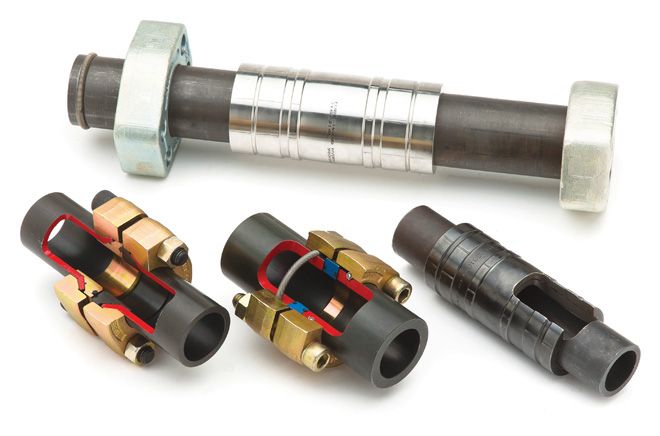When you think hydraulic plumbing, what comes to mind is usually either hoses or tubes. Hoses are easy to make and provide a forgivable installation option. Tubing takes more forethought but is relatively straightforward if you have the proper bending and flaring equipment.

Weldless, threadless plumbing options from Tube Mac
What’s less popular but no less effective, especially for large diameter conduits, is weldless, threadless plumbing. Typically manufactured using proprietary connection systems, they use specialized equipment to permanently crimp together sections of tubing quickly and easily. If you’re not familiar with weldless, threadless plumbing, see the below FAQs for details:
How is weldless, threadless plumbing connected?
These systems are offered in two standard styles. The crimped technology uses a long connector with soft sealing technology located within the ID. Two tube/pipe sections are butted together, and the connector is slid over the two sections and swaged (crimped) against the tubes to create a positive seal.
The flange technology uses flared joints which are interfaced with flanges. A flare slides over the tube before a cone is inserted into the end of each pipe. Long bolts connect the two opposed flanges and are torqued tight to force the flared ends deep into the pipe, expanding it into the tube for a positive seal.
What diameter is available with weldless, threadless plumbing?
Pipe diameter is manufactured up to 10 in. The more common sizes are 2 in. or less because the pressure capacity is reduced for extreme bore pipe. For the crimped style plumbing, smaller sizes are more common because the crimping tool is not manufactured for large bore piping. For flared joint systems, the internal cones and external flanges are offered in sizes up to 10 in., although the pressure capacity for pipe this large is reduced.
What is the pressure rating of weldless, threadless plumbing?
Just like other plumbing systems, the pressure rating is determined by tube diameter, tube wall thickness and the nature of the connection. Systems are available up to 6,000 psi or higher, especially with smaller bore plumbing.
What are the advantages of weldless, threadless plumbing compared to standard tube, pipe or hose?
Depending on the application, or what it replaces, the advantages are its cleanliness (less need to purge or flush the system), installation ease (it’s often easier than making a hose assembly), installation time and reduced safety/inspection requirements. Compared to welded pipe systems, for example, the weldless, threadless system requires specialized brazing and welding and their subsequent inspections.
Filed Under: Hose Assembly Tips